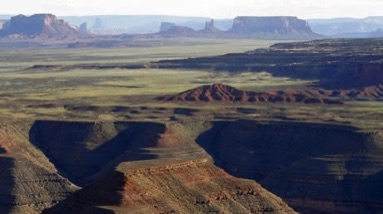The passage below is from a meditation on what it would be like to die of thirst in the desert. It illuminates Abbey’s wish that his body be left in the desert (a fitting final gesture of defiance of convention and law that his friends made sure to honor). For me, in Abbey’s celebration of these “scrawny wings” soaring over the “ruck and rack” of human suffering, there is a lovely echo of the closing stanza of Wallace Stevens’ “Sunday Morning,” where “casual flocks of pigeons make/ Ambiguous undulations as they sink, Downward to darkness, on extended wings.” As different as these passages are, both the rising vultures and the descending pigeons– ordinary birds and therefore fitting substitutes for the dove of the Holy Spirit– become an affirmation of a world of change and our place in it.
See those big black scrawny wings far above, waiting? Comfort yourself with the reflection that within a few hours, if all goes as planned, your human flesh will be working its way through the gizzard of a buzzard, your essence transfigured into the fierce greedy eyes and unimaginable consciousness of a turkey vulture. Whereupon you, too, will soar on motionless wings high over the ruck and rack of human suffering. For most of us a promotion in grade, for some the realization of an ideal.
Desert Solitaire, “Water,” pp 117-118
Edward Abbey’s Vultures
In Desert Solitaire, vultures appear as emblems, not of mortality, but of nature’s transformative power and thus by analogy the transformative power of the imagination and our own fleeting presence– cruel and lovely, marvelous and small– in a world of change.

“Death is the mother of beauty,” Stevens proclaims elsewhere in “Sunday Morning,” which in turn is an echo of Emerson’s proclamation, in Nature, that “even the corpse has its own beauty.” This second passage stems from Abbey’s encounter with a corpse in the desert:

Southwest, toward Grandview Point and The Maze, I can see V-shaped black wings in the lonely sky, soaring higher and higher against a yellow sunset. I think of the dead man under the juniper on the edge of the world, seeing him as the vulture would have seen him, far below and from a great distance. And I see myself through those cruel eyes.
I feel myself sinking into the landscape, fixed in place like a stone, like a tree, a small motionless shape of vague outline, desert-colored, and with the wings of imagination look down at myself through the eyes of the bird, watching a human figure that becomes smaller, smaller in the receding landscape as the bird rises into the evening– a man at a table near a twinkling campfire, surrounded by a rolling wasteland of stone and dune and sandstone monuments, the wasteland surrounded by dark canyons and the course of rivers and mountain ranges on a vast plateau stretching across Colorado, Utah, New Mexico, and Arizona, and beyond this plateau more deserts and greater mountains, the Rockies in dusk, the Sierra Nevadas shining in their late afternoon, and farther and farther yet, the darkened East, the gleaming Pacific, the curving margins of the great earth itself, and beyond earth that ultimate world of sun and stars whose bounds we cannot discover.
Desert Solitaire, “The Dead Man at Grandview Point,” pp 215-16